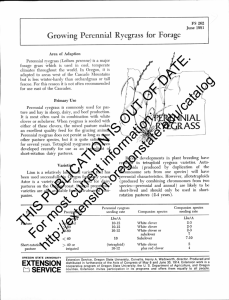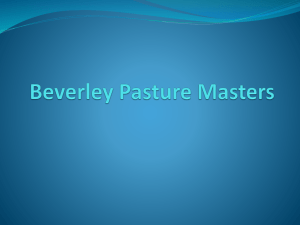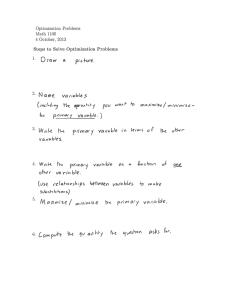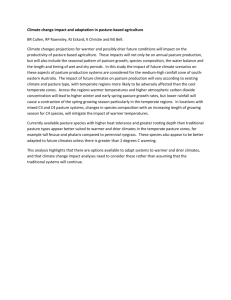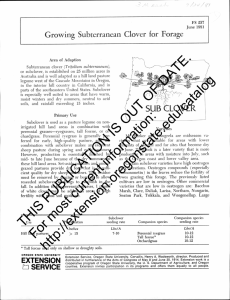FARING FOOTHILL COUNTRY
advertisement
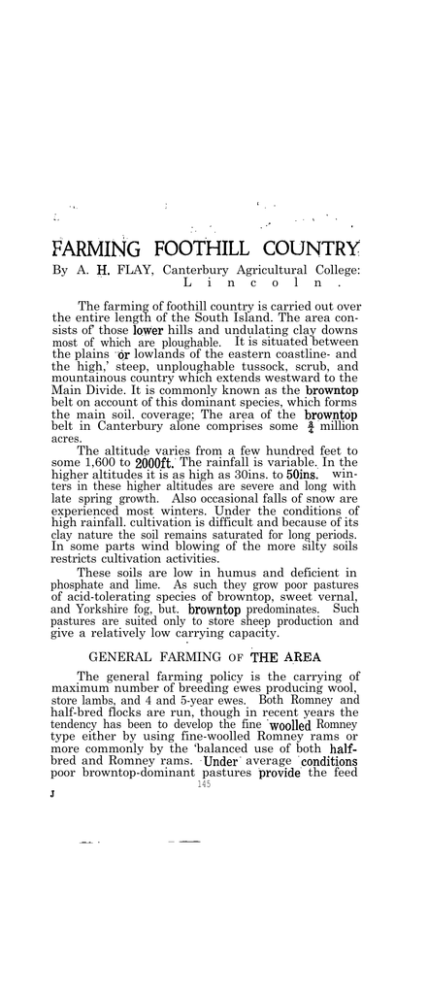
,jl. ,. I., : 1. : :. , ..c’. - _. FARING FOOTHILL COUNTRY By A. l$ FLAY, Canterbury Agricultural College: L i n c o l n . The farming of foothill country is carried out over the entire length of the South Island. The area consists of’ those lotier hills and undulating clay downs most of which are ploughable. It is situated between the plains ~)r lowlands of the eastern coastline- and the high,’ steep, unploughable tussock, scrub, and mountainous country which extends westward to the Main Divide. It is commonly known as the browntop belt on account of this dominant species, which forms the main soil. coverage; The area of the browntop belt in Canterbury alone comprises some 3 million acres. The altitude varies from a few hundred feet to some 1,600 to 26OOft.’ The rainfall is variable. In the higher altitudes it is as high as 30ins. to 50ins. winters in these higher altitudes are severe and long with late spring growth. Also occasional falls of snow are experienced most winters. Under the conditions of high rainfall. cultivation is difficult and because of its clay nature the soil remains saturated for long periods. In some parts wind blowing of the more silty soils restricts cultivation activities. These soils are low in humus and deficient in phosphate and lime. As such they grow poor pastures of acid-tolerating species of browntop, sweet vernal, and Yorkshire fog, but. browntop predominates. Such pastures are suited only to store sheep production and give a relatively low carrying capacity. . GENERAL FARMING OF THE A.REA The general farming policy is the carrying of maximum number of breeding ewes producing wool, store lambs, and 4 and 5-year ewes. Both Romney and half-bred flocks are run, though in recent years the tendency has been to develop the fine ‘woolled Romney type either by using fine-woolled Romney rams or more commonly by the ‘balanced use of both halfbred and Romney rams. .Under- average .conditions poor browntop-dominant pastures hrovide- the feed 145 .J supply for 9 months of the year; the winter feed is supplied largely by roots with a run-off of pasture roughage. A high summer and autumn rainfall produes a. surplus growth which invariably runs to roughage. Sometimes a little hay is made. Pasture renewal takes place along with root production,-the new grass being sown with the roots or after them. Such pasture in the absence of phosphate and lime topdressing soon deteriorates to browntop and sweet vernal. Until very recently little topdressing was practised with the result that the farm unit consisted largely of poor pastures. Grazing. with sheep soon ate out most of the weakly grow!ng palatable species. On the better soils the only sown grass to; survive for a period was perennial ryegrass. Where it was sown thickly so that it dominated the sward browntop and sweet, vernal were kept in check for a while; invasion by browntop and sweet vernal was slowed up. The explanation has been given that this is due to the browntop and sweet vernal while in the young and fresh stage of re-establishment being relatively more palatable than the sown perennial ryegrass. After a year or two as the ryegrass weakens and the browntop and sweet vernal become dominant the area ‘develops into the well-known waving field of unconsumed roughage. .. Carrying capacity has always been limited, by winter and spring feed supplies. With a high rainfall summer growth is good and were it not for this high rainfall together with strong winds haymaking would be a feature of the farm economy. As it is, haymaking has developed but little,’ partly due no doubt as well to the lack of good red clover pasture. Thus the farmers have restricted their winter feed to root crops. These grow well throughout the foothills, but on many farms spurrey or yarr exists in such. intensity and is so vigorous that it frequently restricts maximum yields. Farmers of the area desire a reliable winter feed supply, a minimum of pasture renewal, a maximum total carrying capacity, and in parts an economical gorse control method. These,- along with their inability to fatten lambs, despite the adequacy of summer growth, are some of the problems confronting the farmer of foothill country. MODERN IMPROVEMENTS A realisation that the phosphate and lime deficiency of these soils must be made up is the first step 146 in farm improvement. The use of these has increased substantially in recent years on some foothill farms, but the full expression of their value would scarcely have been possible were it not for New Zealand’s pasture improvement work followed by certification resulting in the production of an improved, vigorous growing white-clover and Montgomery,red clover. The use of these clovers, especially white clover, in the seed mixture of p,erennial ryegrass, cocksfoot, timothy and dogstail has formed the basis of pasture improvement,.increased the life and productivity of sown pastures, and enabled by the aid of topdressing and liming a general increase in stock numbers. With the confidence that improved pastures and increased sheep numbers can now be obtained, greater attention is being given to methods of sowing pasture. An adequate fallow after roots and the sowing of pasture on a well-prepared seed-bed, either alone or with .a light seeding of rape or turnips, are features of pasture improvement. Where possible also lime is applied before the sowing of the pasture. With the increase in stock numbers winter feed provision has become greater and hence extra hay has been made with difficulty and uncertainty as to quality. Modern mechanisation with hay balers has facilitated haymaking, but under the prevailing conditions has not eliminated the risk of wet weather or strong winds at haymaking time. Haymaking is still difficult and uncertain, e‘speci... ally on the higher rainfall areas. In some of the more favoured areas surplus summer growth has been dealt with partly by the saving of highly profitable ryegrass and clover seed crops. Small seeds production, which is a natural corollary Qf improved pastures on the lowlands and plains, met with mixed- results on .thls higher area due to blind -seed disease in ryegrass, wind risk, and wet. weather at harvest. In some districts, however, some very successful small seeds farming has been practised. In areas where grass-grub or porina is troublesome-and this applies mainly to the freer soils of the foothills-D.D.T. applied with the normal topdressing at approximately &year intervals will, it appears, remove the danger of pasture damage and destruction by these insects. The life of the pasture is thus guaranteed. Management it seems now bec.omes a matter of establishing a balance of stock numbers to the im147 ‘proved *inter, spring,- and %dmmer- feed supply eompatible with a sufficient grass area being removed -from summer grazing for’ hay and other purposes and the ploughing of pasture for a maximum-yielding root crop. L _: FUTURE IMPROVEMENTS. .Though -much has been done, there are still substantial areas of the foothills awaiting the application <of existing ‘knowledge of ,improved pastures,. liming and topdressing. There are also further improvements to be, made in the farming of these areas. The most important at the moment and only awaiting greater application-is the production and use of silage., Modern mechanisation has now made it economical to conserve as silage surplus summer growth. It is not : suggested that’ silage should replace hay, but rather. that it be additional thereto. Silage together with hay and roots assisted by autumn-saved grass will provide the future winter feed of the area. At present- in many areas maximum yields of turnips are not possible on account of tieed competition from spurrey or yarr. Spraying the newly establishing crop.with T.C.A. must shortly become economical, where yarr is. troublesome and will result in in.creased yields and also permit the fuller use of post‘drillingf’of roots with ‘superphosphate, a well worth while practice. Higher yields of roots mean a lesser tire6 under cultivation, resulting in ti greater area for. grazing. ~available .In areas, where gorse’ is troublesome .and beyond the reach .of the plough-gullies, steep faces; etc.? there is available an effective spray. Improved pastures and topdressing have brought ,-with them .increased..fat lamb production on many foothill farms, especially in the lower and more favoured areas. On these, latter areas, in fact, fat lamb production is now the order; but. on -many of the higher altitude and higher rainfall areas lamb fattenzing- -is still a difficulty. :Even first-class pastures as .judged by known standards have failed on some farms to .produce the expected fat lambs, both in numbers :off the mothers and in weight. Perhaps on these ‘difficult areas it will be found that there is a deficiency of potash, cobalt, copper, or some other factor. There -is scope .for inquiry into this matter of poor ‘lamb .fattening on foothill farms. 148



